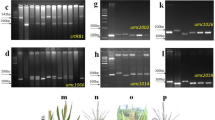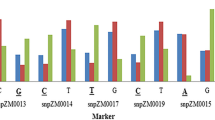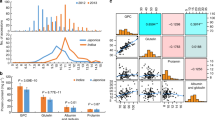Abstract
Breeding to increase β-carotene levels in cereal grains, termed provitamin A biofortification, is an economical approach to address dietary vitamin A deficiency in the developing world. Experimental evidence from association and linkage populations in maize (Zea mays L.) demonstrate that the gene encoding β-carotene hydroxylase 1 (crtRB1) underlies a principal quantitative trait locus associated with β-carotene concentration and conversion in maize kernels. crtRB1 alleles associated with reduced transcript expression correlate with higher β-carotene concentrations. Genetic variation at crtRB1 also affects hydroxylation efficiency among encoded allozymes, as observed by resultant carotenoid profiles in recombinant expression assays. The most favorable crtRB1 alleles, rare in frequency and unique to temperate germplasm, are being introgressed via inexpensive PCR marker-assisted selection into tropical maize germplasm adapted to developing countries, where it is most needed for human health.
This is a preview of subscription content, access via your institution
Access options
Subscribe to this journal
Receive 12 print issues and online access
$209.00 per year
only $17.42 per issue
Buy this article
- Purchase on Springer Link
- Instant access to full article PDF
Prices may be subject to local taxes which are calculated during checkout



Similar content being viewed by others
References
Tanumihardjo, S.A., Bouis, H., Hotz, C., Meenakshi, J.V. & McClafferty, B. Biofortification of staple crops: an emerging strategy to combat hidden hunger. Compr. Rev. Food Sci. Food Safety 7, 329–334 (2008).
Pfeiffer, W.H. & McClafferty, B. HarvestPlus: breeding crops for better nutrition. Crop Sci. 47, S88–S105 (2007).
Fierce, Y. et al. In vitro and in vivo characterization of retinoid synthesis from β-carotene. Arch. Biochem. Biophys. 472, 126–138 (2008).
Harjes, C.E. et al. Natural genetic variation in lycopene epsilon cyclase tapped for maize biofortification. Science 319, 330–333 (2008).
Sun, Z.R., Gantt, E. & Cunningham, F.X. Cloning and functional analysis of the β-carotene hydroxylase of Arabidopsis thaliana. J. Biol. Chem. 271, 24349–24352 (1996).
Tian, L. & DellaPenna, D. Characterization of a second carotenoid β-hydroxylase gene from Arabidopsis and its relationship to the LUT1 locus. Plant Mol. Biol. 47, 379–388 (2001).
Bai, L., Kim, E., DellaPenna, D. & Brutnell, T.P. Novel lycopene epsilon cyclase activities in maize revealed through perturbation of carotenoid biosynthesis. Plant J. 59, 588–599 (2009).
Aluru, M. et al. Generation of transgenic maize with enhanced provitamin A content. J. Exp. Bot. 59, 3551–3562 (2008).
Vallabhaneni, R. et al. Metabolite sorting of a germplasm collection reveals the hydroxylase3 locus as a new target for maize provitamin A biofortification. Plant Physiol. 151, 1635–1645 (2009).
Cunningham, F.X. Jr., Lee, H. & Gantt, E. Carotenoid biosynthesis in the primitive red alga Cyanidioschyzon merolae. Eukaryot. Cell 6, 533–545 (2007).
Vallabhaneni, R. & Wurtzel, E.T. Timing and biosynthetic potential for carotenoid accumulation in genetically diverse germplasm of maize. Plant Physiol. 150, 562–572 (2009).
Li, F., Murillo, C. & Wurtzel, E.T. Maize Y9 encodes a product essential for 15-cis-zeta-carotene isomerization. Plant Physiol. 144, 1181–1189 (2007).
Matthews, P.D. & Wurtzel, E.T in Food Colorants: Chemical and Functional Properties (ed. Sociaciu, C.) 361–368 (CRC Press, Boca Raton, Florida, USA, 2007).
Kurilich, A.C. & Juvik, J.A. Quantification of carotenoid and tocopherol antioxidants in Zea mays. J. Agric. Food Chem. 47, 1948–1955 (1999).
Chander, S. et al. Using molecular markers to identify two major loci controlling carotenoid contents in maize grain. Theor. Appl. Genet. 116, 223–233 (2008).
Yu, J.M. et al. A unified mixed-model method for association mapping that accounts for multiple levels of relatedness. Nat. Genet. 38, 203–208 (2006).
Pritchard, J.K., Stephens, M. & Donnelly, P. Inference of population structure using multilocus genotype data. Genetics 155, 945–959 (2000).
Hardy, O.J. & Vekemans, X. SPAGEDi: a versatile computer program to analyse spatial genetic structure at the individual or population levels. Mol. Ecol. Notes 2, 618–620 (2002).
Fu, Y. et al. Quality assessment of maize assembled genomic islands (MAGIs) and large-scale experimental verification of predicted genes. Proc. Natl. Acad. Sci. USA 102, 12282–12287 (2005).
Wang, S., Basten, C.J. & Zeng, Z. Windows QTL Cartographer 2.5 (North Carolina State University, Raleigh, North Carolina, USA, 2005).
Ooijen, J.W.V. & Voorrips, R.E. JOINMAP version 3.0, Software for the Calculation of Genetic Linkage Maps (Plant Research International, Wageningen, The Netherlands, 2001).
Kandianis, C. Genetic Dissection of Carotenoid Concentration and Compositional Traits in Maize Grain Doctoral dissertation, University of Illinois, Urbana-Champaign. 〈http://hdl.handle.net/2142/14699〉 (December 2009).
Utz, H.F. & Melchinger, A.E. PLABQTL: A Computer Program to Map QTL, Version 1.2 (1993).<https://www.uni-hohenheim.de/plantbreeding/software/>
SAS Institute. SAS/STAT User's Guide Version 9.2 (SAS Institute, Cary, North Carolina, USA, 2008).
Bradbury, P.J. et al. TASSEL: software for association mapping of complex traits in diverse samples. Bioinformatics 23, 2633–2635 (2007).
Acknowledgements
We thank K. Pixley and J. Chandler for seed and field experiment coordination and W. White, P. Bermudez, S. Islam, C. Paul, W. Liu, S. Xu and Y. Zhou for carotenoid HPLC profiling. Helpful comments on the manuscript from J. Wilkinson and J. Yu are appreciated. This research was supported by the US Agency for International Development (T.R.), HarvestPlus (T.R., D.D.P., J.Y., J.L., M.L.W.), National Science Foundation (NSF) DBI-0321467, DBI-0820619 (E.S.B.), NSF DBI-0604923 (T.R.), USDA-ARS (E.S.B.), NSF DBI-0501713 (T.B.), TRIAD Foundation (T.B.), China NSF-30821140352 (J.L., J.Y.), China Scholarship Fund (Y.F.) and JBT Fellowship-UIUC (C.B.K.).
Author information
Authors and Affiliations
Contributions
C.E.H. and J.Y. identified the gene. X.Y., Z.F., Y.F., R.B., C.B.K., J.Y., M.G.S.F., M.Z. and S.M. carried out the sequencing and genotyping. L.B., E.-H.K. and X.Y. carried out the transcript expression and biochemical assays. J.Y. and D.J.S. developed the crtRB1 molecular markers. R.B. and J.Y. supervised the field testing. C.B.K., Z.F., Q.L. and N.P. carried out the carotenoid profiling. C.B.K. and X.Y. completed the genetic mapping and QTL analyses. J.Y. and C.B.K. carried out the association and genetic analyses. The study was designed and supervised by J.Y., J.L., D.D.P., T.B., E.S.B., M.L.W. and T.R. The manuscript was prepared by J.Y., C.B.K., D.J.S., M.L.W. and T.R. and was edited by D.D.P., T.B. and E.S.B.
Corresponding authors
Ethics declarations
Competing interests
The authors declare no competing financial interests.
Supplementary information
Supplementary Text and Figures
Supplementary Figures 1–5 and Supplementary Tables 1–20 (PDF 2955 kb)
Rights and permissions
About this article
Cite this article
Yan, J., Kandianis, C., Harjes, C. et al. Rare genetic variation at Zea mays crtRB1 increases β-carotene in maize grain. Nat Genet 42, 322–327 (2010). https://doi.org/10.1038/ng.551
Received:
Accepted:
Published:
Issue Date:
DOI: https://doi.org/10.1038/ng.551
This article is cited by
-
Enhancement of nutritional quality in maize grain through QTL-based approach
Cereal Research Communications (2024)
-
Unraveling transcriptomics of sorghum grain carotenoids: a step forward for biofortification
BMC Genomics (2023)
-
Hybrid performance evaluation and genome-wide association analysis of root system architecture in a maize association population
Theoretical and Applied Genetics (2023)
-
Genetic and molecular basis of carotenoid metabolism in cereals
Theoretical and Applied Genetics (2023)
-
Enhancement of nutritional quality in maize kernel through marker-assisted breeding for vte4, crtRB1, and opaque2 genes
Journal of Applied Genetics (2023)



